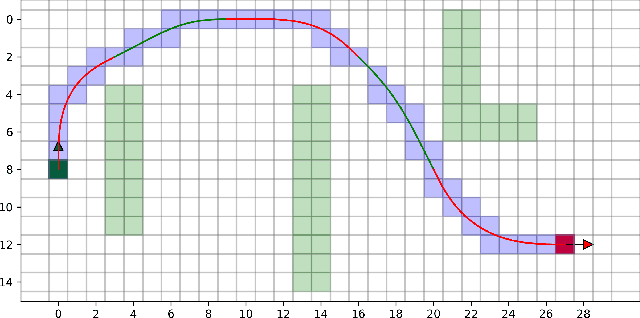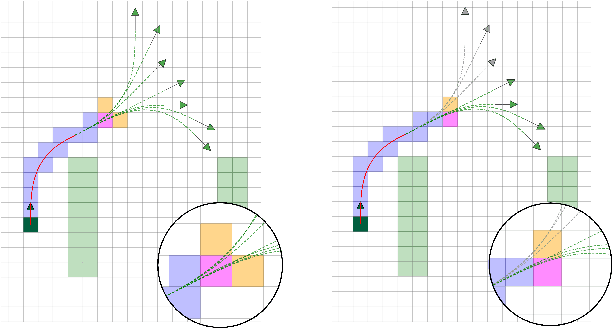Konstantin Yakovlev
Federal Research Center for Computer Science and Control of Russian Academy of Sciences
Decentralized Uncertainty-Aware Multi-Agent Collision Avoidance With Model Predictive Path Integral
Jul 27, 2025Abstract:Decentralized multi-agent navigation under uncertainty is a complex task that arises in numerous robotic applications. It requires collision avoidance strategies that account for both kinematic constraints, sensing and action execution noise. In this paper, we propose a novel approach that integrates the Model Predictive Path Integral (MPPI) with a probabilistic adaptation of Optimal Reciprocal Collision Avoidance. Our method ensures safe and efficient multi-agent navigation by incorporating probabilistic safety constraints directly into the MPPI sampling process via a Second-Order Cone Programming formulation. This approach enables agents to operate independently using local noisy observations while maintaining safety guarantees. We validate our algorithm through extensive simulations with differential-drive robots and benchmark it against state-of-the-art methods, including ORCA-DD and B-UAVC. Results demonstrate that our approach outperforms them while achieving high success rates, even in densely populated environments. Additionally, validation in the Gazebo simulator confirms its practical applicability to robotic platforms.
Multi-Agent Path Finding For Large Agents Is Intractable
May 15, 2025Abstract:The multi-agent path finding (MAPF) problem asks to find a set of paths on a graph such that when synchronously following these paths the agents never encounter a conflict. In the most widespread MAPF formulation, the so-called Classical MAPF, the agents sizes are neglected and two types of conflicts are considered: occupying the same vertex or using the same edge at the same time step. Meanwhile in numerous practical applications, e.g. in robotics, taking into account the agents' sizes is vital to ensure that the MAPF solutions can be safely executed. Introducing large agents yields an additional type of conflict arising when one agent follows an edge and its body overlaps with the body of another agent that is actually not using this same edge (e.g. staying still at some distinct vertex of the graph). Until now it was not clear how harder the problem gets when such conflicts are to be considered while planning. Specifically, it was known that Classical MAPF problem on an undirected graph can be solved in polynomial time, however no complete polynomial-time algorithm was presented to solve MAPF with large agents. In this paper we, for the first time, establish that the latter problem is NP-hard and, thus, if P!=NP no polynomial algorithm for it can, unfortunately, be presented. Our proof is based on the prevalent in the field technique of reducing the seminal 3SAT problem (which is known to be an NP-complete problem) to the problem at hand. In particular, for an arbitrary 3SAT formula we procedurally construct a dedicated graph with specific start and goal vertices and show that the given 3SAT formula is satisfiable iff the corresponding path finding instance has a solution.
Generalization error bound for denoising score matching under relaxed manifold assumption
Feb 19, 2025Abstract:We examine theoretical properties of the denoising score matching estimate. We model the density of observations with a nonparametric Gaussian mixture. We significantly relax the standard manifold assumption allowing the samples step away from the manifold. At the same time, we are still able to leverage a nice distribution structure. We derive non-asymptotic bounds on the approximation and generalization errors of the denoising score matching estimate. The rates of convergence are determined by the intrinsic dimension. Furthermore, our bounds remain valid even if we allow the ambient dimension grow polynomially with the sample size.
Safe Interval Randomized Path Planing For Manipulators
Dec 27, 2024Abstract:Planning safe paths in 3D workspace for high DoF robotic systems, such as manipulators, is a challenging problem, especially when the environment is populated with the dynamic obstacles that need to be avoided. In this case the time dimension should be taken into account that further increases the complexity of planning. To mitigate this issue we suggest to combine safe-interval path planning (a prominent technique in heuristic search) with the randomized planning, specifically, with the bidirectional rapidly-exploring random trees (RRT-Connect) - a fast and efficient algorithm for high-dimensional planning. Leveraging a dedicated technique of fast computation of the safe intervals we end up with an efficient planner dubbed SI-RRT. We compare it with the state of the art and show that SI-RRT consistently outperforms the competitors both in runtime and solution cost. Our implementation of SI-RRT is publicly available at https://github.com/PathPlanning/ManipulationPlanning-SI-RRT
MeshA*: Efficient Path Planing With Motion Primitives
Dec 13, 2024



Abstract:We study a path planning problem where the possible move actions are represented as a finite set of motion primitives aligned with the grid representation of the environment. That is, each primitive corresponds to a short kinodynamically-feasible motion of an agent and is represented as a sequence of the swept cells of a grid. Typically heuristic search, i.e. A*, is conducted over the lattice induced by these primitives (lattice-based planning) to find a path. However due to the large branching factor such search may be inefficient in practice. To this end we suggest a novel technique rooted in the idea of searching over the grid cells (as in vanilla A*) simultaneously fitting the possible sequences of the motion primitives into these cells. The resultant algorithm, MeshA*, provably preserves the guarantees on completeness and optimality, on the one hand, and is shown to notably outperform conventional lattice-based planning (x1.5 decrease in the runtime), on the other hand. Moreover, we suggest an additional pruning technique that additionally decreases the search space of MeshA*. The resultant planner is combined with the regular A* to retain completeness and is shown to further increase the search performance at the cost of negligible decrease of the solution quality.
NavTopo: Leveraging Topological Maps For Autonomous Navigation Of a Mobile Robot
Oct 15, 2024Abstract:Autonomous navigation of a mobile robot is a challenging task which requires ability of mapping, localization, path planning and path following. Conventional mapping methods build a dense metric map like an occupancy grid, which is affected by odometry error accumulation and consumes a lot of memory and computations in large environments. Another approach to mapping is the usage of topological properties, e.g. adjacency of locations in the environment. Topological maps are less prone to odometry error accumulation and high resources consumption, and also enable fast path planning because of the graph sparsity. Based on this idea, we proposed NavTopo - a full navigation pipeline based on topological map and two-level path planning. The pipeline localizes in the graph by matching neural network descriptors and 2D projections of the input point clouds, which significantly reduces memory consumption compared to metric and topological point cloud-based approaches. We test our approach in a large indoor photo-relaistic simulated environment and compare it to a metric map-based approach based on popular metric mapping method RTAB-MAP. The experimental results show that our topological approach significantly outperforms the metric one in terms of performance, keeping proper navigational efficiency.
* This paper is published in proceedings of the 9th International Conference "Interactive Collaborative Robotics" (ICR 2024)
Toolken+: Improving LLM Tool Usage with Reranking and a Reject Option
Oct 15, 2024Abstract:The recently proposed ToolkenGPT tool learning paradigm demonstrates promising performance but suffers from two major issues: first, it cannot benefit from tool documentation, and second, it often makes mistakes in whether to use a tool at all. We introduce Toolken+ that mitigates the first problem by reranking top $k$ tools selected by ToolkenGPT and the second problem with a special "Reject" option such that the model will generate a vocabulary token if "Reject" is ranked first. We demonstrate the effectiveness of Toolken+ on multistep numerical reasoning and tool selection tasks.
MAPF-GPT: Imitation Learning for Multi-Agent Pathfinding at Scale
Aug 29, 2024Abstract:Multi-agent pathfinding (MAPF) is a challenging computational problem that typically requires to find collision-free paths for multiple agents in a shared environment. Solving MAPF optimally is NP-hard, yet efficient solutions are critical for numerous applications, including automated warehouses and transportation systems. Recently, learning-based approaches to MAPF have gained attention, particularly those leveraging deep reinforcement learning. Following current trends in machine learning, we have created a foundation model for the MAPF problems called MAPF-GPT. Using imitation learning, we have trained a policy on a set of pre-collected sub-optimal expert trajectories that can generate actions in conditions of partial observability without additional heuristics, reward functions, or communication with other agents. The resulting MAPF-GPT model demonstrates zero-shot learning abilities when solving the MAPF problem instances that were not present in the training dataset. We show that MAPF-GPT notably outperforms the current best-performing learnable-MAPF solvers on a diverse range of problem instances and is efficient in terms of computation (in the inference mode).
Safe Policy Exploration Improvement via Subgoals
Aug 25, 2024Abstract:Reinforcement learning is a widely used approach to autonomous navigation, showing potential in various tasks and robotic setups. Still, it often struggles to reach distant goals when safety constraints are imposed (e.g., the wheeled robot is prohibited from moving close to the obstacles). One of the main reasons for poor performance in such setups, which is common in practice, is that the need to respect the safety constraints degrades the exploration capabilities of an RL agent. To this end, we introduce a novel learnable algorithm that is based on decomposing the initial problem into smaller sub-problems via intermediate goals, on the one hand, and respects the limit of the cumulative safety constraints, on the other hand -- SPEIS(Safe Policy Exploration Improvement via Subgoals). It comprises the two coupled policies trained end-to-end: subgoal and safe. The subgoal policy is trained to generate the subgoal based on the transitions from the buffer of the safe (main) policy that helps the safe policy to reach distant goals. Simultaneously, the safe policy maximizes its rewards while attempting not to violate the limit of the cumulative safety constraints, thus providing a certain level of safety. We evaluate SPEIS in a wide range of challenging (simulated) environments that involve different types of robots in two different environments: autonomous vehicles from the POLAMP environment and car, point, doggo, and sweep from the safety-gym environment. We demonstrate that our method consistently outperforms state-of-the-art competitors and can significantly reduce the collision rate while maintaining high success rates (higher by 80% compared to the best-performing methods).
POGEMA: A Benchmark Platform for Cooperative Multi-Agent Navigation
Jul 20, 2024Abstract:Multi-agent reinforcement learning (MARL) has recently excelled in solving challenging cooperative and competitive multi-agent problems in various environments with, mostly, few agents and full observability. Moreover, a range of crucial robotics-related tasks, such as multi-robot navigation and obstacle avoidance, that have been conventionally approached with the classical non-learnable methods (e.g., heuristic search) is currently suggested to be solved by the learning-based or hybrid methods. Still, in this domain, it is hard, not to say impossible, to conduct a fair comparison between classical, learning-based, and hybrid approaches due to the lack of a unified framework that supports both learning and evaluation. To this end, we introduce POGEMA, a set of comprehensive tools that includes a fast environment for learning, a generator of problem instances, the collection of pre-defined ones, a visualization toolkit, and a benchmarking tool that allows automated evaluation. We introduce and specify an evaluation protocol defining a range of domain-related metrics computed on the basics of the primary evaluation indicators (such as success rate and path length), allowing a fair multi-fold comparison. The results of such a comparison, which involves a variety of state-of-the-art MARL, search-based, and hybrid methods, are presented.
 Add to Chrome
Add to Chrome Add to Firefox
Add to Firefox Add to Edge
Add to Edge